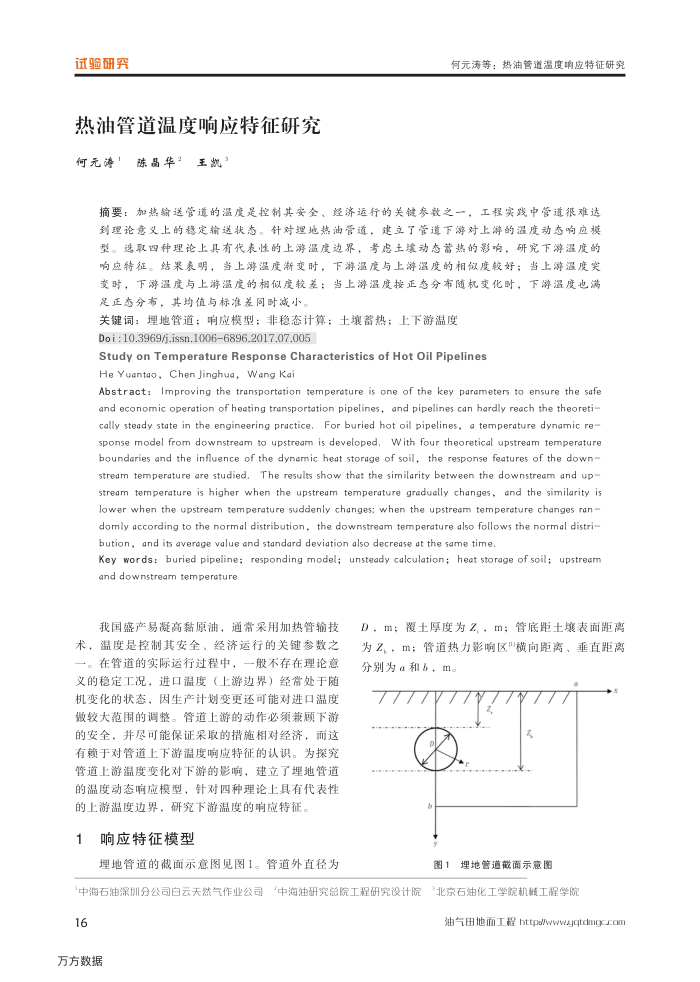您当前的位置:首页>论文资料>热油管道温度响应特征研究
内容简介
 试验研究
试验研究热油管道温度响应特征研究
何元涛1
陈昌华2
王凯”
何元涛等:热油管道温度响应特征研究
摘要:加热输送管道的温度是控制其安全、经济运行的关键参数之一,工程实践中管道很难达到理论意义上的稳定输送状态。。
针对理地热油管道,建立了管道下游对上游的温度动态响应模
型。选取四种理论上其有代表性的上游温度边界,考土境动态蓄热的影响,研完下游温度的响应特征。结果表明,当上游温度渐变时,下游温度与上游温度的相似度较好;当上游温度突变时,下游温度与上游温度的相似度较差:当上游温度按正态分布随机变化时,下游温度也满足正态分布,其均值与标准差同时减小。
关键词:埋地管道;响应模型;非稳态计算;土壤蓄热;上下游温度 Doi :10.3969/j.issn.10066896.2017.07.005
Study on Temperature Response Characteristics of Hot Oil Pipelines He Yuantao, Chen Jinghua, Wang Kai
Abstract: Improving the transportation temperature is one of the key parameters to ensure the safe and economic operation of heating transportation pipelines, and pipelines can hardly reach the theoreti cally steady state in the engineering practice.
For buried hot oil pipelines, a temperature dynamic re
With four theoretical upstream temperature
sponse model from downstream to upstream is developed.
boundaries and the influence of the dynamic heat storage of soil, the response features of the down
.The results show that the similarity between the downstream and up
stream temperature are studied.
stream temperature is higher when the upstream temperature graduelly changes, and the similarity is lower when the upstream temperature suddenly changes; when the upstream temperature changes ran domly dccording to the normal distribution , the downstream temperature also follows the normal distri bution, and its average value and standard deviation also decredse at the same time.
Key words: buried pipeline; responding model; unsteady calculation; heat storage of soil; upstream and downstream temperature
我国盛产易凝高黏原油,通常采用加热管输技术,温度是控制其安全、经济运行的关键参数之
在管道的实际运行过程中,一般不存在理论意义的稳定工况,进口温度(上游边界)经常处于随机变化的状态,因生产计划变更还可能对进口温度傲较大范围的调整。管道上游的动作必须兼顾下游的安全,并尽可能保证采取的措施相对经济,而这有赖于对管道上下游温度响应特征的认识。为探究管道上游温度变化对下游的影响,建立了埋地管道的温度动态响应模型,针对四种理论上具有代表性的上游温度边界,研究下游温度的响应特征。
响应特征模型
埋地管道的截面示意图见图1。管道外直径为
D,m:覆土厚度为Z.,m;管底距土壤表面距离为Z、,m;管道热力影响区"横向距离、垂直距离分别为a和,m。
埋地管道截面示意图图1
中海石油深圳分公司白云天然气作业公司
“中海油研究总院工程研究设计院
16 万方数据
“北京石油化工学院机械工程学院
油气田地面工程http/wwwayqtdmgc.cam
上一章:原油掺水集输流程方案优选
下一章:生态袋防护措施在山区长输管道水工保护中的应用